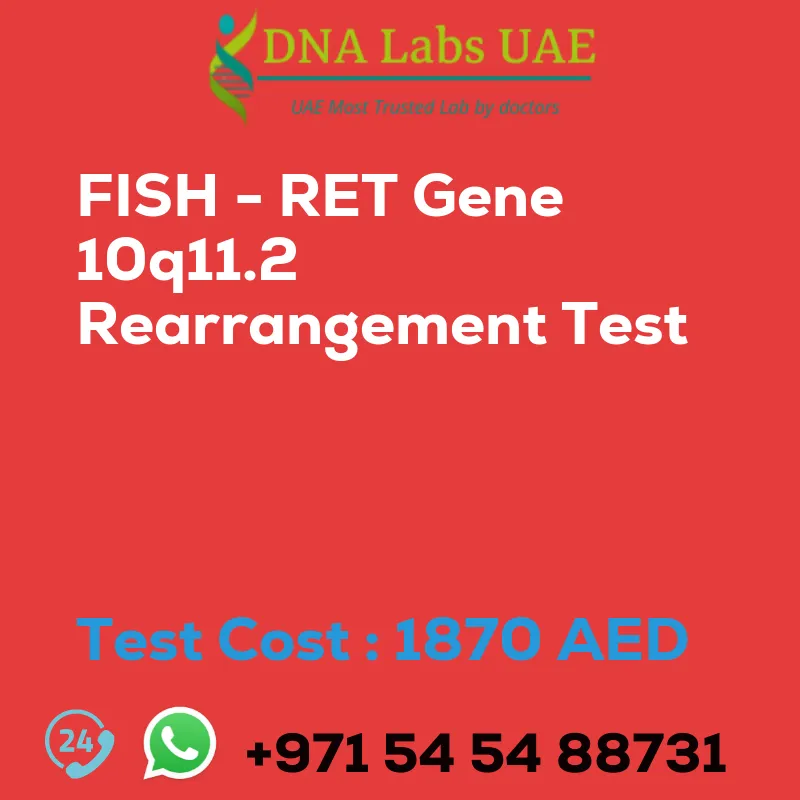FISH – RET GENE 10q11.2 REARRANGEMENT Test
Test Name: FISH – RET GENE 10q11.2 REARRANGEMENT Test
Test Components: Price: 1870.0 AED
Sample Condition: Submit Formalin fixed paraffin embedded tissue block. Ship at room temperature. Tissue block must contain 10% tumor tissue. Duly filled Chromosome & FISH analysis Requisition Form (Form 17) is mandatory.
Report Delivery: Sample Daily by 4 pm; Report 4 Working days
Method: FISH
Test Type: Cancer
Doctor: Oncologist
Test Department: CYTOGENETICS
Pre Test Information: Duly filled Chromosome & FISH analysis Requisition Form (Form 17) is mandatory.
Test Details
The FISH – RET gene (10q11.2) rearrangement test is a diagnostic test used to detect rearrangements in the RET gene located on chromosome 10q11.2. RET rearrangements are genetic alterations that can occur in certain types of cancer, particularly thyroid cancer and lung cancer. The RET gene encodes a receptor tyrosine kinase that plays a crucial role in cell growth and differentiation.
When the RET gene undergoes rearrangement, it can result in the fusion of RET with other genes, leading to the formation of abnormal proteins with constitutive activation of the RET kinase domain. This abnormal activation of RET signaling pathways can contribute to the development and progression of cancer.
The FISH (fluorescence in situ hybridization) technique is used to detect these rearrangements by labeling specific DNA probes with fluorescent dyes. These probes can then bind to the RET gene and its fusion partners, allowing for visualization and identification of any rearrangements. The test can be performed on tissue samples obtained from biopsies or surgical specimens.
The FISH – RET gene rearrangement test is particularly useful in identifying specific subtypes of thyroid cancer, such as papillary thyroid carcinoma (PTC) and medullary thyroid carcinoma (MTC), which frequently harbor RET rearrangements. It can also be used in the diagnosis of lung adenocarcinoma, as some cases may have RET gene rearrangements.
Detection of RET gene rearrangements can have important implications for patient management and treatment decisions. For example, targeted therapies that specifically inhibit the abnormal RET kinase activity have been developed and can be effective in patients with RET-positive tumors. Therefore, identifying patients with RET rearrangements through the FISH test can help guide treatment strategies and improve patient outcomes.
| Test Name | FISH – RET GENE 10q11.2 REARRANGEMENT Test |
|---|---|
| Components | |
| Price | 1870.0 AED |
| Sample Condition | Submit Formalin fixed paraffin embedded tissue block. Ship at room temperature. Tissue block must contain10% tumor tissue. Duly filled Chromosome & FISH analysis Requisition Form (Form 17) is mandatory. |
| Report Delivery | Sample Daily by 4 pm; Report 4 Working days |
| Method | FISH |
| Test type | Cancer |
| Doctor | Oncologist |
| Test Department: | CYTOGENETICS |
| Pre Test Information | Duly filled Chromosome & FISH analysis Requisition Form (Form 17) is mandatory. |
| Test Details |
The FISH – RET gene (10q11.2) rearrangement test is a diagnostic test used to detect rearrangements in the RET gene located on chromosome 10q11.2. RET rearrangements are genetic alterations that can occur in certain types of cancer, particularly thyroid cancer and lung cancer. The RET gene encodes a receptor tyrosine kinase that plays a crucial role in cell growth and differentiation. When the RET gene undergoes rearrangement, it can result in the fusion of RET with other genes, leading to the formation of abnormal proteins with constitutive activation of the RET kinase domain. This abnormal activation of RET signaling pathways can contribute to the development and progression of cancer. The FISH (fluorescence in situ hybridization) technique is used to detect these rearrangements by labeling specific DNA probes with fluorescent dyes. These probes can then bind to the RET gene and its fusion partners, allowing for visualization and identification of any rearrangements. The test can be performed on tissue samples obtained from biopsies or surgical specimens. The FISH – RET gene rearrangement test is particularly useful in identifying specific subtypes of thyroid cancer, such as papillary thyroid carcinoma (PTC) and medullary thyroid carcinoma (MTC), which frequently harbor RET rearrangements. It can also be used in the diagnosis of lung adenocarcinoma, as some cases may have RET gene rearrangements. Detection of RET gene rearrangements can have important implications for patient management and treatment decisions. For example, targeted therapies that specifically inhibit the abnormal RET kinase activity have been developed and can be effective in patients with RET-positive tumors. Therefore, identifying patients with RET rearrangements through the FISH test can help guide treatment strategies and improve patient outcomes. |








